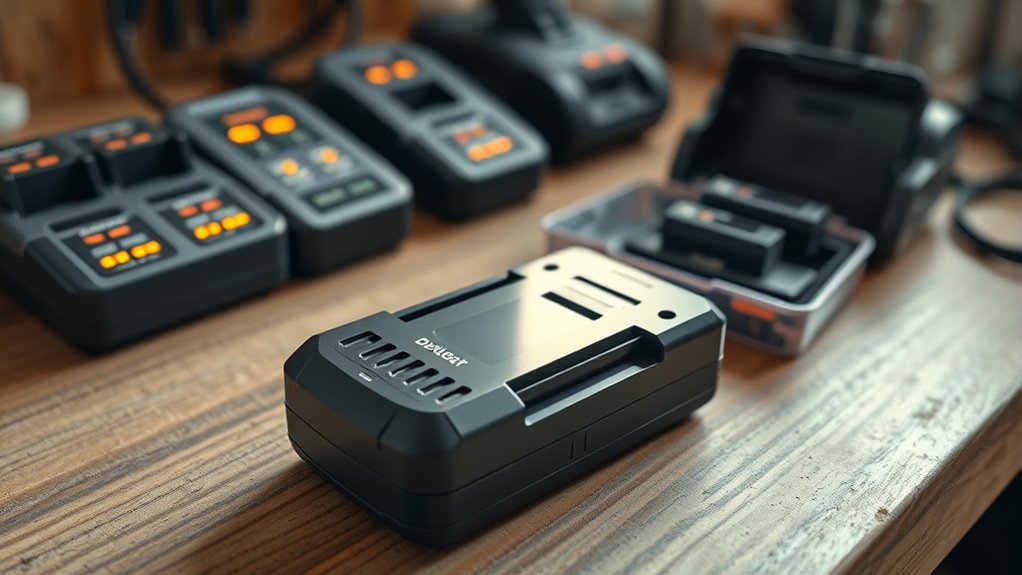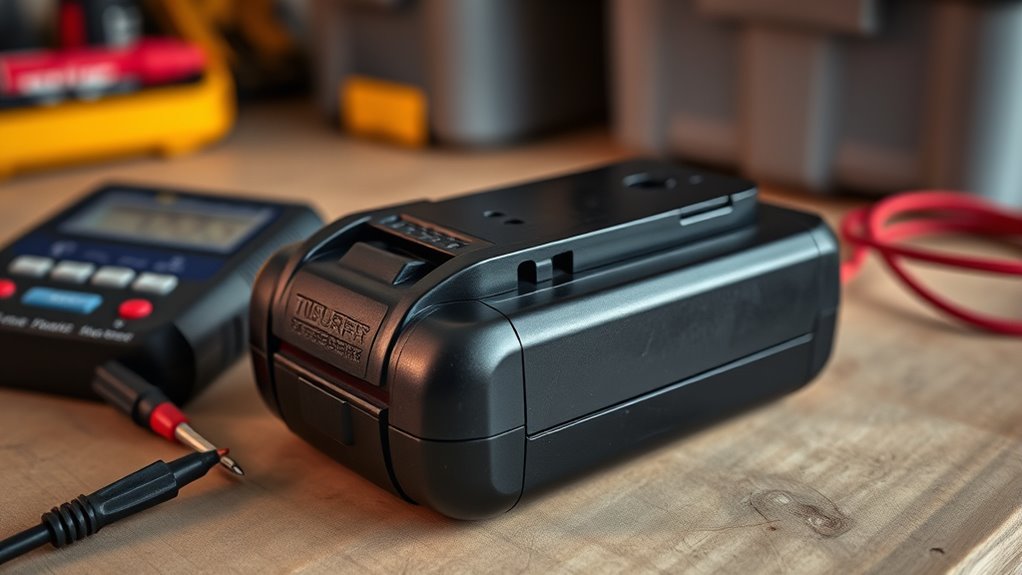To care for your cordless tool batteries, aim to keep them between 40-60% charged during storage and avoid full drain or constant full charges. Unplug the charger once fully charged to prevent heat buildup, which can shorten battery life. Store batteries in a cool, dry place away from sunlight and extreme temperatures. Managing charge cycles and proper storage helps extend battery lifespan. If you keep learning, you’ll discover even more tips to maximize your batteries’ performance.
Key Takeaways
- Recharge batteries at 20-30% capacity to minimize stress and extend lifespan.
- Unplug chargers once batteries reach 100% to prevent overcharging and heat buildup.
- Store batteries in a cool, dry place at 40-60% charge for optimal long-term health.
- Remove batteries from tools if unused for extended periods and check periodically.
- Manage charge cycles by avoiding frequent full discharges and maintaining moderate use to prolong battery life.

Taking proper care of your cordless tool batteries can greatly extend their lifespan and guarantee ideal performance. One of the most effective ways to do this is by paying attention to your battery’s charging habits. Your batteries are designed to handle a specific number of charge cycles, which refers to the process of charging and discharging. Every time you fully charge and drain the battery, you’re using up part of its lifespan. To maximize the longevity of your batteries, it’s best to avoid letting them fully discharge frequently. Instead, aim to recharge them when they reach about 20-30% capacity. This practice reduces stress on the battery and can help prevent premature wear. Also, try not to leave your batteries on the charger indefinitely after they’re fully charged. Overcharging can generate heat, which may degrade the cells over time. Many modern chargers have built-in mechanisms to prevent this, but it’s still good practice to unplug once the battery hits 100%. Consistent, moderate charging habits ultimately lead to a longer-lasting battery and fewer replacements.
In addition to mindful charging habits, how you store your batteries plays a vital role in preserving their health. If you’re not going to use your cordless tools for a while, it’s best to remove the batteries and store them separately in a cool, dry place. Extreme temperatures, especially heat, can accelerate chemical reactions inside the battery, causing capacity loss and reducing the overall battery lifespan. Conversely, storing batteries in very cold environments can temporarily diminish their ability to hold a charge and may cause damage if they’re frozen. Aim for a storage temperature around 50°F (10°C), and keep the batteries away from direct sunlight and moisture. It’s also wise to store batteries with a partial charge—around 40-60%—rather than fully charged or completely drained. This level of charge helps maintain the chemical stability within the cells and prevents capacity loss over time. Regularly check the stored batteries every few months, and recharge them to the recommended level if they’ve lost some capacity. Additionally, understanding the concept of charge cycles can help you better manage the lifespan of your batteries and plan for replacements before they fail unexpectedly.
Frequently Asked Questions
How Do Temperature Fluctuations Affect Battery Lifespan?
Temperature fluctuations can substantially impact your battery’s lifespan. When you don’t practice proper temperature management, extreme heat or cold can cause the battery to degrade faster. Thermal regulation helps maintain a stable environment, preventing capacity loss and prolonging its life. Always store your cordless tool batteries in a cool, dry place, and avoid exposing them to rapid temperature changes. Proper thermal regulation ensures your battery stays healthy and lasts longer.
Can Overcharging Damage Cordless Tool Batteries?
Yes, overcharging can damage your cordless tool batteries by reducing their overall capacity. When you leave the battery on the charger too long, it can cause overheating and stress the cells, leading to diminished battery life. To protect your battery capacity, stick to proper charging routines, unplug once fully charged, and avoid leaving batteries on chargers unnecessarily. This helps guarantee your batteries stay healthy and perform at their best longer.
What Is the Ideal Humidity Level for Storage?
Imagine a dry, desert breeze versus a humid rainforest—your storage environment should mirror the dry side. Keep humidity levels between 40-60% for ideal moisture control. Too high, and moisture can damage your batteries; too low, and static buildup becomes a risk. Use humidity monitoring devices to maintain this balance and protect your batteries from corrosion and deterioration, ensuring they stay in top condition longer.
How Often Should I Calibrate My Battery?
You should calibrate your battery every 3 to 6 months to guarantee accurate charge cycle readings and ideal performance. Regular calibration helps your battery’s management system understand its true capacity, preventing premature degradation. To calibrate, fully charge the battery, then let it drain completely before recharging. This process resets the battery’s internal statistics, maintaining accurate charge cycle frequency tracking and extending its lifespan.
Are There Specific Brands With Better Battery Longevity?
Some brands have better battery longevity thanks to their reputation for quality and durability. You should look for brands like Milwaukee, DeWalt, and Makita, which are known for reliable battery performance. Make certain the batteries are compatible with your tools to guarantee maximum lifespan. Choosing reputable brands with good reviews helps you avoid frequent replacements and ensures your tools stay powered longer.
Conclusion
Taking good care of your cordless tool batteries can extend their lifespan considerably. Remember, batteries typically last around 300-500 charge cycles—meaning if you charge it daily, it could still serve you for over a year! Proper storage and avoiding complete discharges prevent capacity loss. By following these simple tips, you’ll save money and keep your tools ready whenever you need them. Keep your batteries happy, and they’ll keep working hard for you!









